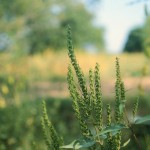Marshelder, Narrowleaf Marshelder, Narrowleaf Sumpweed
Iva angustifolia DC.
Asteraceae (Sunflower Family)
Description
Marshelder is a native, warm-season annual that is also commonly named Narrowleaf Sumpweed. A member of the Sunflower family, it is characterized by its leaf-like bracts in the flowering stem. Marshelder is very drought tolerant. It can reach 1 to 4.5 ft or 0.3 to 1.4 m tall. This plant germinates in the early spring, in February or March, and is mostly vegetative with erect stems. The leaves are narrow and lance-linear to linear in shape. The leaves are also simple, with entire or serrate margins, alternate or opposite, and have a petiolate attachment. The flowers, which resemble those of the ragweed group, are inconspicuous. It flowers in late summer and fall, typically from August to November. Though seldom eaten, Sumpweeds cause abortion in cattle. The pollen from this group is also a noted human allergen.Habitat
Marshelder occurs on seepy areas or those that may hold some water in the spring, especially along the edges of creeks and ponds. It is commonly found in moist soils on disturbed sites and overgrazed pastures.Toxic Agent
The toxin in Narrowleaf Marshelder is unknown. This plant is often very abundant and is unavoidably grazed heavily. Consumption has been associated with abortions at 4 to 8 months of gestation when cattle ate large amounts of the young plants in the two- to eight-leaf stage of growth. In experiments, rabbits fed the plant as 50 percent of their diet either gave birth prematurely or had stillborn or weak pups that died by 3 days old.Signs of Livestock Ingestion
Cattle consuming a large amount of young Narrowleaf Marshelder in mid-gestation can show the following signs: Premature mammary development; Dripping milk; Abortion. Affected cows breed back normally.Management Strategies
Cows in mid-gestation should not be placed in dry pastures that contain sub-irrigated areas heavily infested with Narrowleaf Marshelder if little forage is available in other areas. The time of breeding can be altered so that plants are large enough for cows to avoid them during mid-gestation. Severe infestations may be controlled with broadleaf herbicides such as 2,4-D or Grazon P+D® at 0.5-to-1.0-pound a.i./acre in the spring with good growing conditions.Images
Plant Characteristics
Flower Color: Green, White, Yellow
Seed Type: Non-Encapsulated
Duration: Annual, Biennial
Stem Texture: Hairless/Smooth
Growth Habit: Forbs/Broadleaf
Leaf Shape
 : Simple with Pinnate or Parallel Venation
: Simple with Pinnate or Parallel Venation
Season: Warm
Distribution
 : 01 - Pineywoods, 02 - Gulf Prairies and Marshes, 03 - Post Oak Savannah, 04 - Blackland Prairies, 05 - Cross Timbers and Prairies, 07 - Edwards Plateau
: 01 - Pineywoods, 02 - Gulf Prairies and Marshes, 03 - Post Oak Savannah, 04 - Blackland Prairies, 05 - Cross Timbers and Prairies, 07 - Edwards Plateau
Distributions
Distribution refers to the ecological region in Texas that a plant has been found. You can also view a clickable map.
Book: Brush and Weeds of Texas Rangelands (B-6208), Toxic Plants of Texas (B-6105)
Collection: Brush and Weeds, Toxics
Livestock Affected: Cattle, Rabbits
Livestock Signs: Abortion, Premature Mammary Development, Unthrifty Offspring






